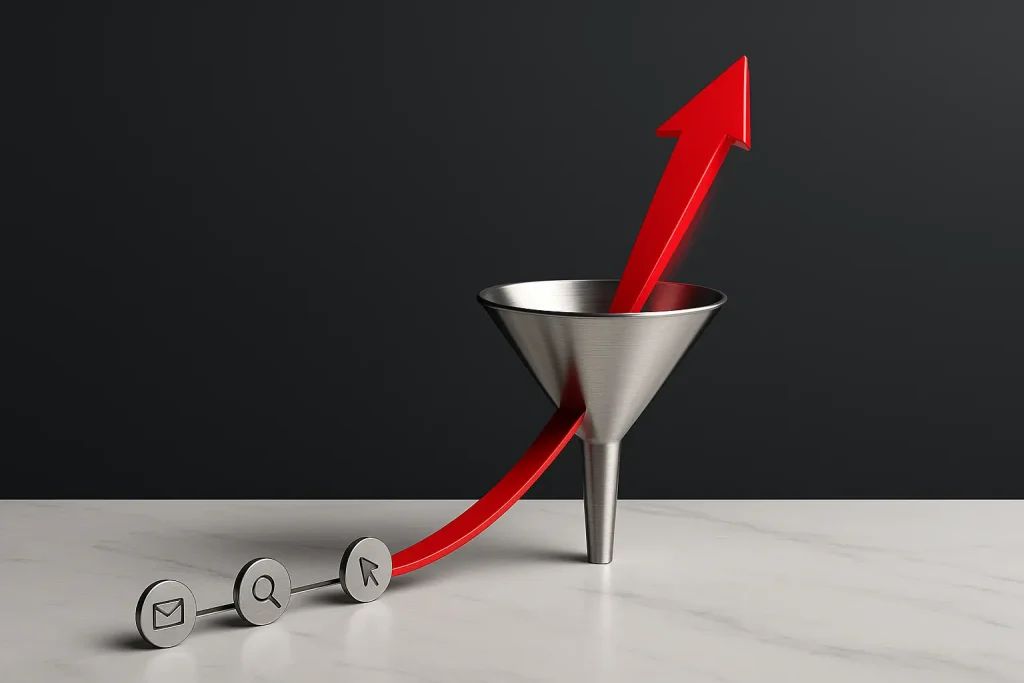The fastest way to improve your return on creative is to treat data like a compass, not a map, then point it at bigger swings.

Marketing leaders tell me the same story. Budgets are tight, attention is tighter, and every dashboard screams for a tweak. Yet profits rarely move with button color tests. When we blend data with creative courage, results climb, teams align, and work gets a lot more fun.
I am David, and this is how I build data‑driven creative marketing for grown‑up brands. Not timid, not templated, not machine‑made. Human first, numbers fluent.
The mindset: data‑driven creative marketing is a compass
Data helps us decide where to steer, it does not dictate every turn. When a team believes this, ideas get braver, reviews get faster, and the work stops looking like everyone else’s. We do not worship spreadsheets, we translate signals into choices.
Practical view:
- Instinct counts as data, so does taste, so does lived experience. Document it. If a creative director has shipped one hundred ads, their pattern memory is a real dataset. Capture those patterns in short notes, then validate them with controlled tests.
- Dashboards matter, yet the narrative matters more. Click‑through without comments, saves, or replies means curiosity without conviction. Comments without clicks means a message that moves people but fails to direct them. We read both.
- The job is not to find a magic formula. The job is to connect a clear idea with the right viewer, then learn fast enough to scale the winners.
The signal stack: from hook to hold to action
Hook earns time, hold earns trust, clarity earns action.
We use a simple hierarchy to read creative performance. It keeps marketers and creatives in the same room, speaking the same language.
Hook, the scroll‑stop test
The first task is to earn attention. On short‑form video, aim for a strong hook rate, which is the percentage of impressions that reach three seconds. If the hook is weak, nothing else matters. Fix the first frame, the first line, the first second. Use contrast, movement, or a visual reveal.
Hold, the story test
Once you have attention, hold it. Track the share of hooked viewers who watch to your chosen milestone, for example, a ThruPlay or a 50 percent view. This is where pacing, structure, and product clarity do the heavy lifting.
Click, the intent test
Great creatives create a reason to act. We look for efficient cost per click, yet we never read it alone. A high click with low quality landing behavior means curiosity without clarity. A moderate click with deep scroll and time on site often beats the shiny spike.
Convert, the business test
Finally, measure the action that pays the bills, and keep two views, attributed performance and incremental lift. Attribution tells you how the platform sees things. Incrementality tells you what truly changed for the business. Use both, stay honest.
The plan: move beyond micro‑tests, test the idea
Small tweaks have a place, big swings build brands. Instead of testing four button colors, test four different stories. Instead of one safe message, develop ten concepts that actually disagree with each other.
Do not polish a maybe, find a winner, then multiply it.
How we run it at The Hyper Fuel:
- Concept batch, 8 to 12 ads. Each ad expresses a different idea, not a tiny edit. We vary angles, offers, framing, and talent. We keep the audience constant to isolate creative.
- Guardrails, before we spend. We agree on make‑or‑break metrics, for example, hook rate above 35 percent, cost per quality click within range, and a minimum sample for read confidence.
- Fast cycles, weekly or bi‑weekly. We run short sprints to find direction, then we scale a few winners. Afterwards, we open a fresh batch and repeat.
- Winners’ tree. Every winning concept spawns three to five thoughtful variants, not clones. New hook, same idea. New talent, same promise. New proof, same outcome.
The measurement layer: privacy‑safe, decision‑ready
Modern measurement needs two lenses. First, what the platforms report, which is fast and directional. Second, what experiments and models confirm, which is slower and decisive. When the numbers disagree, experiments win.
Your practical stack:
- Platform view for speed. We monitor hook, hold, click‑through, cost per result, frequency, creative fatigue, and placement mix. We map patterns by audience and format, then we act within two days.
- Incrementality view for truth. We run conversion lift or geo holdouts for the channels that drive scale. Even one test per quarter gives the team a reality check, especially when budgets climb.
- MMM view for big moves. We adopt a modern media mix model when the spend spans many channels, including offline. It guides quarterly budget shifts and explains the halo effects that models like MTA cannot see.
The creative rules: data‑driven creative marketing that still feels human
Clarity beats hype, especially when buyers defend the spend internally.
Great creative is specific, visual, and confident. Data helps us choose which truths to amplify. Here is the checklist we use when we evaluate a concept.
Story starters that hook
- A strong reveal in the first second, for example, a bold claim on screen, a pattern break, or a surprising before and after
- A spoken line that names the pain clearly, for example, “Procurement took nine months, our tool cut that to nine days”
- Motion with purpose, not motion for motion’s sake
Proof that travels
- Show the product doing the job, not a vague benefit
- Use one number, not seven. Cost saved, time saved, error rate cut, or lifetime value improved
- Borrow credibility, for example, a quick reference to a respected framework or a recognizable customer segment
Direction without pushiness
- Make the next step feel low risk, a demo with your data, a 5 minute planner, a self‑guided tour
- Use plain words in buttons and links, view pricing, build a plan, try the interactive demo
The playbook: build one team, one goal, one scoreboard
When marketing and creative share a scoreboard, stress falls and ideas rise. We celebrate wins together, we learn from losses together, and we never blame the person who took a smart risk.
Rituals that keep us aligned:
- Monday, creative standup, 15 minutes. We skim the scoreboard, celebrate one micro‑win, and highlight one learning. We assign two fixes for the next batch.
- Wednesday, idea clinic, 30 minutes. We bring rough cuts and raw scripts. Feedback is specific, not subjective. We talk about hook, hold, proof, and clarity, not taste alone.
- Friday, growth review, 30 minutes. We compare platform results with lift tests or model insights. If something does not line up, we flag it for a deeper look, then we keep momentum.
Shared scoreboard fields:
- Hook rate, Hold rate, Click‑through rate, Cost per quality click, Add to cart rate or lead form start rate, Conversion rate, Incremental lift when available, Spend, Frequency, Creative age in days
The toolkit: data‑driven creative marketing, ready to run
Creativity loves structure, just not bureaucracy.
Below is a compact toolkit you can copy. It keeps the system light, repeatable, and friendly to both sides of the table.
Creative scorecard
- Hook score, three‑second plays divided by impressions
- Hold score, ThruPlays divided by three‑second plays, or 50 percent view rate
- Clarity score, a simple qualitative check, does the offer make sense to a first‑time viewer
- Action score, cost per quality click within target, or view to signup rate
Test types
- Concept tests, different messages, problems, or promises
- Format tests, UGC, motion design, product close‑ups, founder to camera, split screen with captions
- Offer tests, price framing, trial length, guarantee form, value stack order
- Landing tests, headline match, visual match, and scroll depth to time on page
Fatigue monitors
- Frequency creeping past your brand comfort, cost per result rising while hook stays flat, sharp drop in hold rate after week one, or comments turning repetitive. When you see two of the four, rotate.
Practical examples, the kind teams adopt fast
The right story does not add complexity, it removes doubt.
Example A, B2B workflow tool
- Big idea, stop selling features, sell reclaimed hours
- Two concepts to try,
- Nine to five is too short, a time‑lapse storyboard that shows nine hours of work reduced to three, with the saved hours labeled by role
- Inbox archaeology, a founder on camera pulls a week of buried approvals into the light, then clicks one path that removes three steps
- Success markers, hook above 40 percent on short video, meeting booked rate above your baseline within the first week, and a lift test scheduled after four weeks of spend
Example B, SaaS security platform
- Big idea, show the unseen risk before you pitch the fix
- Two concepts to try,
- The five silent breaches, a split screen that names five near misses that CFOs care about, then shows one place to see them early
- Boardroom rehearsal, a VP rehearses a board update, the tool fills the screen with a plain language narrative, no jargon, no fear tactics
- Success markers, hold above 55 percent on a 20 second edit, comments from real roles that repeat your language, and a drop in time to first call from qualified leads
SEO, without the stiff copy
We respect search intent, we never let it flatten our voice. For this article, the focus keyphrase is data‑driven creative marketing. Natural synonyms include data‑driven creativity, performance creative, and creative analytics. You will see them in headings where they fit, you will never feel them forced.
We place the primary phrase in the title, the H1, the opening, one H2, one image alt, and the close. Secondary phrases appear where they serve the reader. Semantic variants show up once or twice, then we move on. If a line reads like SEO copy, we rewrite it in human terms.
FAQ, your search‑friendly braintrust on data‑driven creative marketing
It is the practice of using audience and performance signals to guide creative decisions, from idea selection to edit order to message framing. We still make art, we simply choose which art to scale with evidence.
Start with hook rate for attention, hold rate for story, click‑through for intent, and cost per qualified action for efficiency. Add incremental lift to know what actually changed for the business.
Watch frequency, hook decay, and rising costs. Many brands rotate every two to four weeks on Meta and faster on TikTok. High spend with narrow audiences requires quicker cycles. Plan small refreshes weekly, plan new concepts monthly.
Yes, for narrow questions. However, when you need direction, big concept tests beat micro‑tweaks. Test ideas first, refine elements later.
If your spend spans many channels or includes offline, yes. MMM explains the big picture, especially halo effects and diminishing returns. Use it for quarterly or biannual budget moves.
Create a shared scoreboard, keep the language plain, review together twice a week, and celebrate wins together. Make the target the team’s target, not one function’s burden.
Use ABCD to structure the story, then measure hook, brand presence in the first five seconds, and clear direction at the end. Pair platform results with site behavior to confirm quality.
A ten‑concept test that explores different problems, promises, and proofs. Keep the audience constant, spend evenly, and pick winners by signal quality, not vanity metrics.
Research snapshots, why this approach works now
The market keeps changing, the physics of attention do not.
You do not need to take my word for it. Across the industry, creative quality shows up as a primary driver of results, and privacy shifts reward teams that test big ideas and measure with experiments.
- Major studies consistently credit creative quality with a large share of sales lift. Different sources place it near half of the impact. The lesson is simple, improve the idea first, then fine tune the media.
- Short‑form platforms reward strong first seconds. Hook metrics, for example three‑second plays over impressions, are practical early indicators. When hook rises, downstream results usually follow.
- Privacy changes reduced user‑level tracking, so marketers adopted more experiments and returned to aggregated models like MMM. Teams that combine platform speed with experimental truth make better quarterly calls.
A quick rollout, from talk to traction
You can put this system in place in one month without slowing current programs. Here is a clear plan.
Set the compass
- Align on one North Star, for example, qualified demos or repeat purchase revenue
- Define guardrails, target hook rate, hold rate, and an acceptable range for cost per quality click
- Build a shared scoreboard in your current BI or a simple sheet, keep the fields human
Launch the first concept batch
- Brief three distinct ideas, then produce eight to twelve ads across two formats
- Keep audience and budgets constant, so the read is clean
- Publish early in the week, gather comments and early signals by mid‑week
Pattern review and pruning
- Compare hook and hold across ideas, highlight comments that repeat your language
- Pause clear laggards, trim the middle, keep two to four winners in market
- Create three variants for each winner, new openers, new talent, or new proof
Scale and schedule the first experiment
- Increase spend on two winners, hold coverage with the rest
- Book a conversion lift test or a geo holdout for next month on the channel with the most scale
- Document the learning in a one‑page memo, what to make more of, what to avoid
Data‑driven creative marketing that moves people and numbers
Data‑driven creative marketing works because it respects both sides of the job. We use data to steer, we use creativity to move hearts, and we use experiments to keep ourselves honest. Start with a concept batch, keep a shared scoreboard, and let the results point the way.
If you want this system set up in your world, we can help. Send me your current top three ads, and I will turn them into a starter scorecard in one day.





